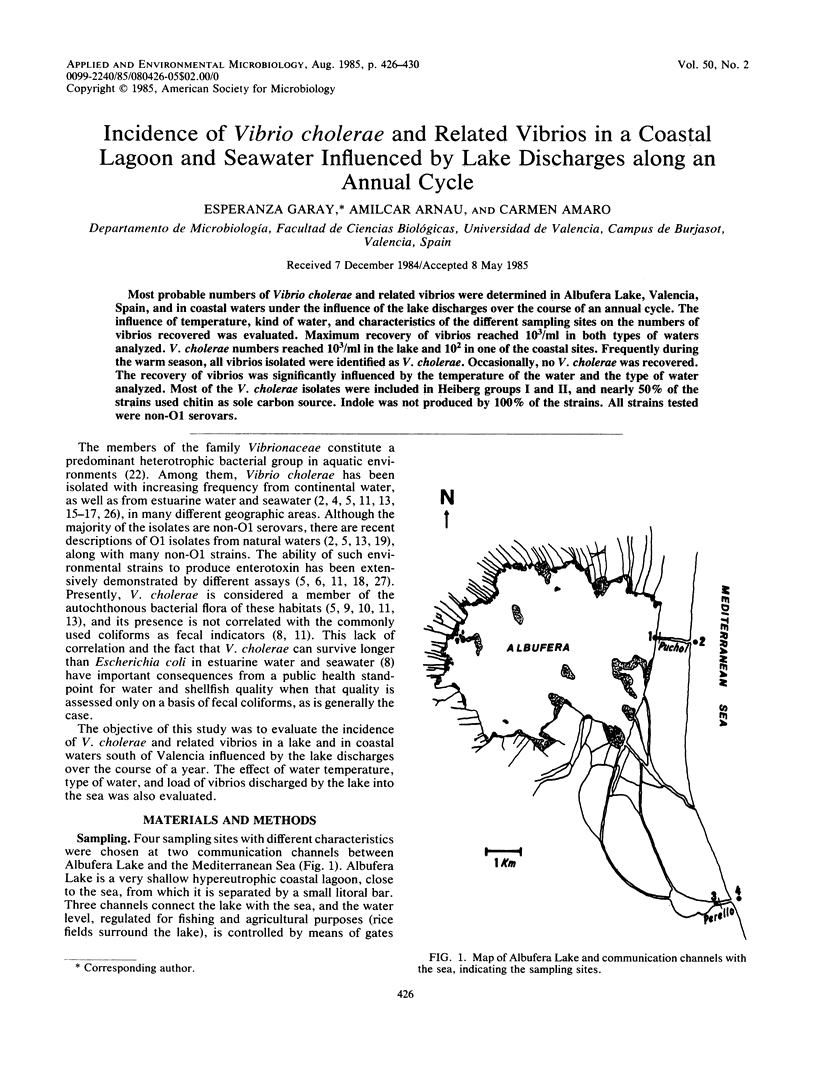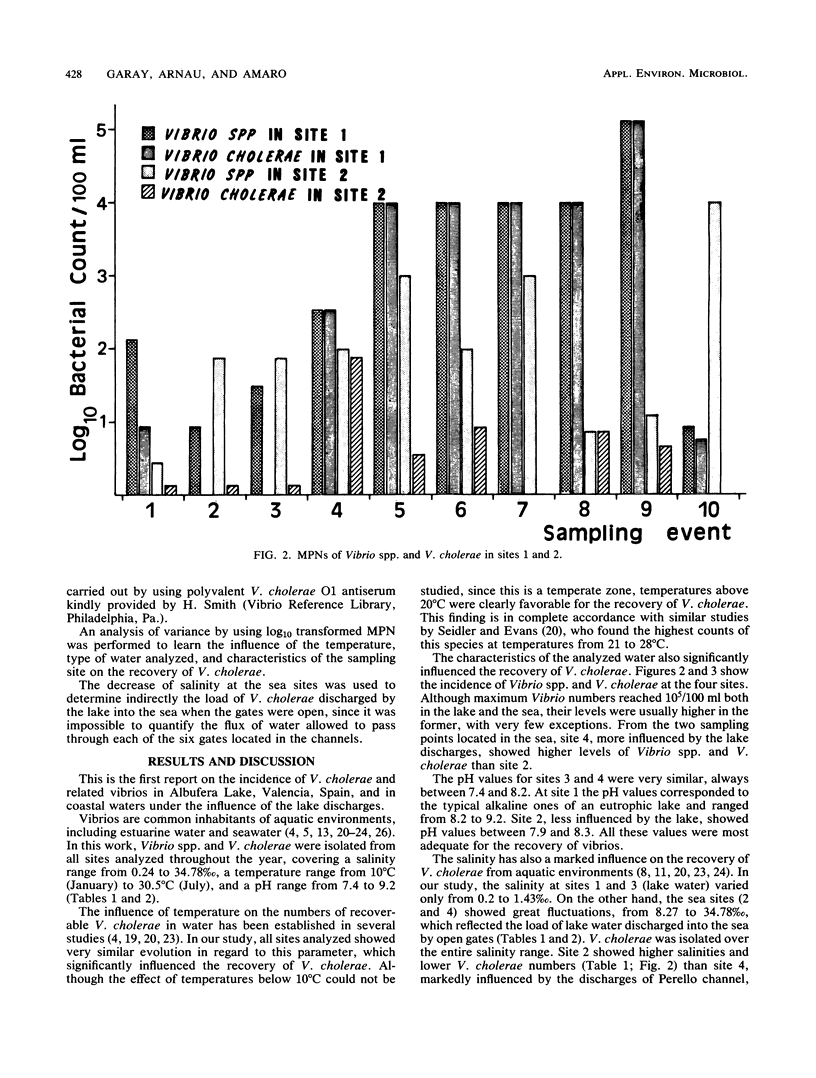Abstract
Most probable numbers of Vibrio cholerae and related vibrios were determined in Albufera Lake, Valencia, Spain, and in coastal waters under the influence of the lake discharges over the course of an annual cycle. The influence of temperature, kind of water, and characteristics of the different sampling sites on the numbers of vibrios recovered was evaluated. Maximum recovery of vibrios reached 10(3)/ml in both types of waters analyzed. V. cholerae numbers reached 10(3)/ml in the lake and 10(2) in one of the coastal sites. Frequently during the warm season, all vibrios isolated were identified as V. cholerae. Occasionally, no V. cholerae was recovered. The recovery of vibrios was significantly influenced by the temperature of the water and the type of water analyzed. Most of the V. cholerae isolates were included in Heiberg groups I and II, and nearly 50% of the strains used chitin as sole carbon source. Indole was not produced by 100% of the strains. All strains tested were non-O1 serovars.
Full text
PDF




Selected References
These references are in PubMed. This may not be the complete list of references from this article.
- Bashford D. J., Donovan T. J., Furniss A. L., Lee J. V. Vibrio cholerae in Kent. Lancet. 1979 Feb 24;1(8113):436–437. doi: 10.1016/s0140-6736(79)90906-1. [DOI] [PubMed] [Google Scholar]
- Citarella R. V., Colwell R. R. Polyphasic taxonomy of the genus Vibrio: polynucleotide sequence relationships among selected Vibrio species. J Bacteriol. 1970 Oct;104(1):434–442. doi: 10.1128/jb.104.1.434-442.1970. [DOI] [PMC free article] [PubMed] [Google Scholar]
- Colwell R. R., Kaper J., Joseph S. W. Vibrio cholerae, Vibrio parahaemolyticus, and other vibrios: occurrence and distribution in Chesapeake Bay. Science. 1977 Oct 28;198(4315):394–396. [PubMed] [Google Scholar]
- Colwell R. R., Seidler R. J., Kaper J., Joseph S. W., Garges S., Lockman H., Maneval D., Bradford H., Roberts N., Remmers E. Occurrence of Vibrio cholerae serotype O1 in Maryland and Louisiana estuaries. Appl Environ Microbiol. 1981 Feb;41(2):555–558. doi: 10.1128/aem.41.2.555-558.1981. [DOI] [PMC free article] [PubMed] [Google Scholar]
- Draskovicová M., Karolcek J., Winkler Experimental Toxigenicity of NAG Vibrios. Zentralbl Bakteriol Orig A. 1977 Feb;237(1):65–71. [PubMed] [Google Scholar]
- Hood M. A., Ness G. E. Survival of Vibrio cholerae and Escherichia coli in estuarine waters and sediments. Appl Environ Microbiol. 1982 Mar;43(3):578–584. doi: 10.1128/aem.43.3.578-584.1982. [DOI] [PMC free article] [PubMed] [Google Scholar]
- Huq A., Small E. B., West P. A., Huq M. I., Rahman R., Colwell R. R. Ecological relationships between Vibrio cholerae and planktonic crustacean copepods. Appl Environ Microbiol. 1983 Jan;45(1):275–283. doi: 10.1128/aem.45.1.275-283.1983. [DOI] [PMC free article] [PubMed] [Google Scholar]
- Kaper J., Lockman H., Colwell R. R., Joseph S. W. Ecology, serology, and enterotoxin production of Vibrio cholerae in Chesapeake Bay. Appl Environ Microbiol. 1979 Jan;37(1):91–103. doi: 10.1128/aem.37.1.91-103.1979. [DOI] [PMC free article] [PubMed] [Google Scholar]
- Lee J. V., Bashford D. J., Donovan T. J., Furniss A. L., West P. A. The incidence of Vibrio cholerae in water, animals and birds in Kent, England. J Appl Bacteriol. 1982 Apr;52(2):281–291. doi: 10.1111/j.1365-2672.1982.tb04852.x. [DOI] [PubMed] [Google Scholar]
- Morris G. K., Merson M. H., Huq I., Kibrya A. K., Black R. Comparison of four plating media for isolating Vibrio cholerae. J Clin Microbiol. 1979 Jan;9(1):79–83. doi: 10.1128/jcm.9.1.79-83.1979. [DOI] [PMC free article] [PubMed] [Google Scholar]
- Müller G. Befunde an nicht-agglutinierenden, cholera-ähnlichen Vibrionen (NAG's) in Abwasser, Flusswasser und Meerwasser. Zentralbl Bakteriol Orig B. 1977 Dec;165(5-6):487–497. [PubMed] [Google Scholar]
- Müller H. E. Vorkommen und Okologie von NAG-Vibrionen in Oberflächengewässern. Zentralbl Bakteriol B. 1978 Sep;167(3):272–284. [PubMed] [Google Scholar]
- Näcescu N., Ciufecu C. Serotypes of Nag Vibrios isolated from clinical and environmental sources. Zentralbl Bakteriol Orig A. 1978 Apr;240(3):334–338. [PubMed] [Google Scholar]
- Oashi M., Shimada T., Fukumi H. In vitro production of enterotoxin and hemorrhagic principle by Vibrio cholerae, NAG. Jpn J Med Sci Biol. 1972 Jun;25(3):179–194. doi: 10.7883/yoken1952.25.179. [DOI] [PubMed] [Google Scholar]
- Rogers R. C., Cuffe R. G., Cossins Y. M., Murphy D. M., Bourke A. T. The Queensland cholera incident of 1977. 2. The epidemiological investigation. Bull World Health Organ. 1980;58(4):665–669. [PMC free article] [PubMed] [Google Scholar]
- Simidu U., Ashino K., Kaneko E. Bacterial flora of phyto- and zoo-plankton in the inshore water of Japan. Can J Microbiol. 1971 Sep;17(9):1157–1160. doi: 10.1139/m71-184. [DOI] [PubMed] [Google Scholar]
- Singleton F. L., Attwell R. W., Jangi M. S., Colwell R. R. Influence of salinity and organic nutrient concentration on survival and growth of Vibrio cholerae in aquatic microcosms. Appl Environ Microbiol. 1982 May;43(5):1080–1085. doi: 10.1128/aem.43.5.1080-1085.1982. [DOI] [PMC free article] [PubMed] [Google Scholar]
- Singleton F. L., Attwell R., Jangi S., Colwell R. R. Effects of temperature and salinity on Vibrio cholerae growth. Appl Environ Microbiol. 1982 Nov;44(5):1047–1058. doi: 10.1128/aem.44.5.1047-1058.1982. [DOI] [PMC free article] [PubMed] [Google Scholar]
- Turova T. P., Antonov A. S. Skhodstvo polinukleotidnykh posledovatel'nostei DNK kholernykh i tak nazyvaemykh neaggliutiniruiushchikhsia vibrionov. Zh Mikrobiol Epidemiol Immunobiol. 1977 Jul;(7):47–50. [PubMed] [Google Scholar]
- West P. A., Lee J. V. Ecology of Vibrio species, including Vibrio cholerae, in natural waters in Kent, England. J Appl Bacteriol. 1982 Jun;52(3):435–448. doi: 10.1111/j.1365-2672.1982.tb05074.x. [DOI] [PubMed] [Google Scholar]
- Zinnaka Y., Carpenter C. C., Jr An enterotoxin produced by noncholera vibrios. Johns Hopkins Med J. 1972 Dec;131(6):403–411. [PubMed] [Google Scholar]


